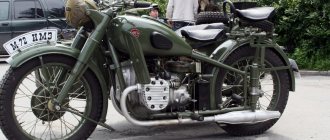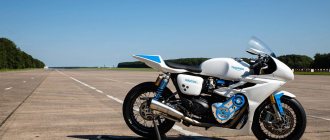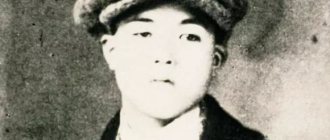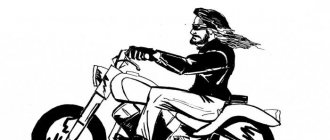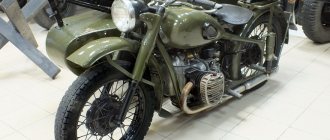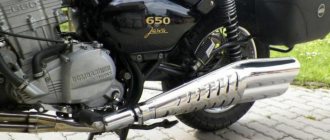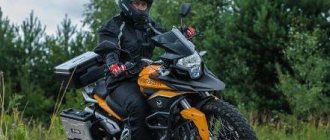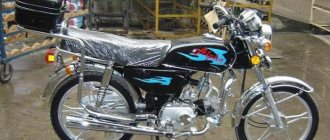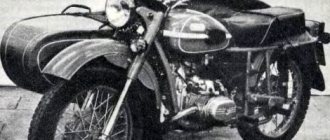History of BMW motorcycles
The legendary German brand, which is well known for producing cars, also has its roots in the motorcycle industry. BMW's first motorcycle, the R32, was built in 1923, and the Flat-Twin engine system is still in use today. BMW is known for its premium bikes that can cover long distances. However, the current range is aimed more at young and fast riders.
1913
Bayerische Motoren Werke founded. The company produces aircraft engines.
1918
The Prussian Army orders 2,000 BMW Model IIIa aircraft engines.
1919
The aircraft, powered by an upgraded Model IV engine, sets a flight record at altitudes of more than 32,000 feet. Just a few weeks later, the Treaty of Versailles is signed and Germany is prohibited from producing aircraft. BMW focuses on motorcycles.
1920
Development of the Courier 148 cc two-stroke engine. cm.
1921
Development of M2 B15. This is BMW's first flat-twin - or "boxer". The engine is based on an earlier aircraft design.
1922
Development of the first light alloy cylinder head.
1923
Legendary BMW designer Max Freese locks himself in his house and works on creating a completely new motorcycle. R 32 with a displacement of 486 cm3 was presented at the Salon in Paris. This is a big improvement over the M2 B15 models. Its top speed is about 60 mph.
1925
Presentation of the racing version of the R 32 - R 37. The R39 also makes its debut, and the front brakes are installed on the R 32.
1927
BMW is developing the R 47 to replace the R 32, R 37 and R 39.
1928
BMW releases its largest motorcycle yet, the 750cc. See R 62 with a top speed of 71 mph.
1929
Paul Koeppen wins the 500cc class at the famous Targa Florio road race in Sicily. BMW will also win this race in the next two years. Ernst Henn uses a 750cc supercharged Kompressor motorcycle. cm on a closed section of highway to set a new land speed record. That's over 134 mph.
1930
The economic downturn in Germany forces BMW to produce the 198cc R2 motorcycle. cm. This machine was the first to use a one-piece “tunnel” crankcase. Smaller motorcycles (less than 200 cc) did not require a license in Germany, and the R 2 sold over 15,000 units.
1932
R 4 edition with 398 cc single cylinder overhead valve engine. cm.
1933
The German army orders BMW to build the R 4, which helps the company stay in business despite the Great Depression.
1935
Launch of the 745cc R 12. This is the first production model to be equipped with a hydraulic front fork.
1936
Launch of the R 5, BMW's first motorcycle with suspension and rear piston. There is also a 500cc R 7, which can reach speeds of up to 87 mph. Otto Ley wins the 500cc Swedish Grand Prix. see on another “compressor”. BMW's supercharged motorcycles would be the dominant force in Grand Prix racing until World War II. After the war, the FIM prohibits the use of forced-fed induction motors. Some interpreted this rule as a punishment for the Allied powers. Because the most successful supercharged racing bikes were the German and Italian single cylinders favored by British manufacturers.
1937
Bavarian policeman and off-road racer Georg Meyer tries to race a BMW ROAD-RACER motorcycle. He pulls out after a few laps, saying he's afraid of going too fast.
1938
Starting with the R 61, BMW introduced rear suspension for all production models. Six new models were introduced this year, including the R 23, R 51, R 66 and R 71. The R 71 is the latest BMW motorcycle to feature a side-valve engine.
1939
Georg Meyer wins the Isle of Man TT race on a BMW motorcycle. With the outbreak of World War II, BMW again turned its attention to aircraft production.
1941
BMW introduces the R 75, which was developed for military use. Weighing 925 pounds, the R 75 had a 750cc engine. cm, large fuel tank, two seats and a stroller. It could also be equipped with a machine gun. The US Army is impressed with the R 75 and similar Zundapp models. Seized German motorcycles are sent to Harley-Davidson and Indian companies. About 1,000 prototypes were created, but these bikes were never used.
1946
After the end of the war, BMW is unable to produce motorcycles and turns its attention to the production of bicycles. To overcome the bitterness, German patents are considered for damages, and the French company CMR (later known as Ratier) begins building a BMW clone.
1948
BMW begins production of the R 24 motorcycle again. The company's first post-war motorcycle, the R 24, is equipped with a 250 cc engine. cm, the maximum engine capacity that was allowed at that time.
1949
BMW presents the R 50/2 and R 51/2 models. Both are considered failures because the main rear bearing was moved into the crankcase and required replacement every 10,000 miles.
1950
The R 25 is introduced with lowered rear suspension.
1952
BMW produces the R 67 model with a displacement of 600 cm3, equipped with a sidecar.
1953
BMW begins production of the RS series, equipped with rear swingarms and Earles forks. In addition, the R 25 was redesigned and released as the R 25/3. Presentation of the serial racing RS54 Rennsport.
1954
The team of Wilhelm Noll and Fritz Krohn wins the World Motocross Championship. Their victory marks the beginning of an amazing phase; BMW will win 19 of 21 world titles in a row!
1955
The R 50, which also has a rear swingarm and a guide front fork, replaces the R 51/3.
1956
Walter Zeller finished second in the 500cc World Championship, behind John Surtees. This is BMW's best solo performance in the modern era.
1957
Motorcycle production fell from 23,531 to 5,429 in 1959 due to the economic crisis.
1960
Release of the classic R 69 S. It is the fastest Boxer available at the time, with a top speed of 109 mph. The R 27 was also released, which features a rubber motor that reduces vibration.
1967
Special export versions of the R 60 and R 69 were produced for the US market, but no new models were produced from 1961 to 1968.
1969
Release of the /5 series with an electric starter. The R 50/5, R 60/5 and R 75/5 are equipped with telescopic front forks.
1973
BMW celebrates its 50th anniversary and the 500,000th BMW motorcycle rolls off the production line. The R 90 S will be launched with a 900cc engine. The /6 series was also introduced in 600, 700 and 900 cc versions. Cm.
1974
For the first time, BMW is offering five-speed transmissions in production motorcycles.
1976
BMW presents the /7 1000cc R 100/7 model. Also presented is the R 100 RS with the same 1000 cc engine. cm and a maximum speed of 200 km/h. This is the first production motorcycle with a full fairing. Helmut Dahne wins the Isle of Man TT (1000cc). Reg Pridmore becomes the first ever winner of the AMA “Production Superbike” championship on a Geitl R90S.
1977
The R80/7 was introduced and became the police motorcycle of choice.
1978
Luxurious R100RT with full fairing introduced. The 473cc R 45 was also introduced.
1980
R80G/S 800 cc engine introduced. See with a single-acting pendulum. The initials stand for Gelände/Strasse, which means "ground and street" in German.
1981
Hubert Auriol wins third place in the Paris-Dakar race in an R80G/S prepared by HPN, the German tuning specialist who continues to equip BMWs.
1982
BMW introduces the road version of the R80G/S, the R80RT.
1983
The K100 is introduced, the first water-cooled K series. This is the first series of motorcycles with electronic ignition and fuel injection with a top speed of 132 km/h. A racing version called the K100RS was also introduced.
1985
BMW builds its first three-cylinder motorcycle, the K75. This bike has a lot in common with the K100, but is more economical and maneuverable.
1986
BMW relaunches R100RS with Monolever rear suspension and 60 PS engine.
1987
The R100RT is back on the market. It has Monolever rear suspension and smaller engines. BMW will also debut a double-jointed single-sided control arm. The luxury 1000cc cruiser K100LT was also introduced.
1988
R100G/S goes into production. With a weight of 463 pounds, it is known as the "world's largest off-road motorcycle."
1989
Production K1. At the time, BMW adhered to a voluntary engine power limit of 100 hp. To maximize performance without exceeding this limit, designers create a striking aerodynamic body. It allows the 600-pound machine to accelerate to 140+ mph and features the world's first digital engine electronics system installed on a production motorcycle. This is incomprehensible to the (then) conservative BMW drivers. As a consequence, it would be withdrawn within a few years due to poor sales.
1990
Introducing the four-valve version of the K100RS. ABS is now standard on all K Series motorcycles.
1991
The millionth BMW motorcycle was born - the three-cylinder K75RT. BMW is starting to equip its motorcycles with three-way catalytic converters. The company is also re-releasing its R100R.
1993
Launch of the R1100RS sports touring motorcycle. The motorcycle is powered by a two-cylinder engine with a fuel injection system.
1994
The first BMW F650 Funduro single since the 1930s and the first four-valve GS, the R1100GS, appear.
1995
This is the last year the traditional two-valve Boxer is produced.
1996
Introduction of the powerful K1200RS four-cylinder liquid-cooled engine.
1997
BMW introduces its first chopper/cruiser, the R1200C. It's James Bond's choice, but it's not enough to make him very popular. It will be withdrawn in a few years.
1999
Richard Saint wins Paris-Dakar in a racing 650 cc single-cylinder “Funduro”. Officially, this motorcycle is designated as F650RR.
2000
BMW is releasing the R1150GS as well as a new luxury estate, the K1200LT.
2004
The R1200GS features a completely new, lighter and more powerful Boxer Twin engine. K1200S is a fundamentally new device for a respected manufacturer. It features a 167-horsepower four-cylinder engine in the frame. For the first time in many years, BMW has demonstrated its willingness to compete directly with the world's largest motorcycle manufacturers.
2007
The company is releasing news about the S1000RR, the four-cylinder motorcycle it will be competing in the 2009 World Superbike Championship. The 2009 S1000RR sportbike announces significant changes. Many aspects of the motorcycle, including the engine and suspension, remain traditional. Although BMW used its expertise in electronics to develop an advanced traction control system.
2011
Unable to rest on its laurels, the brand produces the K1600GT and K1600GTL models. Billed as the ideal machine for tackling miles and winding roads, the K1600 series is the first BMW motorcycle to be powered by a six-cylinder engine.
Post Views: 2,024
Similar articles:
I drove a rare BMW R18 with a boxer engine: I tell you what has changed in it over 97 years
My first encounter with the new BMW R18 cruiser took place a year ago at EICMA 2021, when it was still just a prototype. Back then it was remembered for its classic shape and powerful boxer engine, and it did not leave visitors to the exhibition indifferent.
97 years have passed from the birth of the first BMW motorcycle with a boxer engine to our time. Did BMW chief engineer Max Fritz know then that he would soon create a unique R32 motorcycle with a boxer, transversely deployed engine, with a gearbox in a separate unit, with a driveshaft transmitting torque to the rear wheel? And that exactly this concept will be in demand to this day!
It’s nice to see how German engineers and designers, respecting the history of the brand, try to preserve all the best that Max laid down back in 1923: the fundamentals of the design of the main components and assemblies and classic forms. How carefully modern technologies are introduced so that there is no dissonance, so that everything looks harmonious and simple.
Inspired by the legendary R5, BMW Motorrad designers have created a truly classic cruiser for 2021 - the R18 represents the evolution of a Bavarian brand with a clearly visible pedigree. It’s just a pity that there are so few descendants of the first models... (One of the most controversial - R1200C - was produced from 1996 to 2004, but for some reason did not meet with understanding on the market, and the Germans stopped developing this direction.)
The appearance of the BMW R18 really differs little from the concept. At first, the landing does not seem very comfortable; out of habit, you want to stretch your legs forward a little, but due to the huge 1800 cc boxer engine, there is no space under the cylinders and the footpegs are located almost in the middle of the motorcycle.
The difference between the concept and the production model is small.
You quickly get used to the location of the gear shift: it has a double-arm paw and a dry single-plate clutch; an additional self-reinforcing and slipping mechanism is used, which makes shifting easier. The foot brake is also close to the footpeg and it takes some time to get used to.
All optics are LED.
The rest of the controls are in familiar, convenient places, and a small LCD screen with a trip computer is integrated into the analogue speedometer, showing all the necessary information: total and daily mileage, selected gear, engine speed, driving mode - Rain, Roll or Rock: they are included in basic equipment with automatic stability control ASC, which, if desired, can be turned off and burn rubber. Also included as standard equipment is the MSR engine torque braking system.
When starting the engine, which is only possible with the clutch depressed, even in neutral gear, the engine, like a pendulum, makes a slight jerk from side to side, but then, like an obedient animal, quietly purring, it freezes in anticipation of the next command from its owner. The engine runs so nicely that you want to listen to it for hours, both at idle and on the road, mentally imagining how the gears rotate in it...
While driving, the unit does not ask for mercy, gurgling pitifully or squealing angrily, but unquestioningly responds to the position of the gas handle and easily, playfully accelerates from any gear. Maximum torque of 158 Nm is achieved at 3000 rpm, and 150 Nm is available from 2000 rpm, allowing you to quickly switch to 6th gear and simply enjoy the ride.
The cruiser would do well to add cruise control.
The suspension is set up perfectly! The diameter of the front fork, stylized with authentic shrouds, is 49 mm, like on an old BMW R5. Suspension travel is 120 mm. The rear monoshock with a diameter of 90 mm is hidden under the seat. The engineers did their best: the suspension handles all the bumps well, impacts are practically not felt either in the hands or on the butt, and with a considerable weight of 365 kg, the motorcycle is controlled very easily. This is due to the low center of gravity of the boxer engine. When you lay down the R18 on serpentines, the first thought that comes to mind is that now you will start striking the asphalt not with “soldiers” (folding pins under the footpegs), but with the impressive “pots” of the 1800 cc engine. But as soon as you understand that the step is the first to meet the asphalt, the pleasure of driving on mountain roads becomes pure, without any admixture of worries about the safety of the test (and even more so your own!) equipment.
At a speed of more than 120 km/h, you want to hide from the oncoming wind behind the windshield, which, by the way, is purchased additionally, as well as side bags with a volume of 15.5 liters - not a superfluous accessory on long journeys.
In my opinion, the BMW R18 turned out to be very successful technically, visually, conceptually and ideologically - healthy competition with a well-known American manufacturer will only benefit the entire heavy cruiser market!
Source
